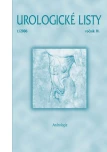ROLE OF THE UROLOGIST IN THE DIAGNOSIS AND THE THERAPY OF THE COUPLE'S INFERTILITY IN IVF PROGRAM
Authors:
MUDr. Vladimír Sobotka 1; MUDr. Jiří Heráček 2,3
Authors‘ workplace:
Sanatorium Pronatal, Praha
1; Urologická klinika 3. LF UK a FN KV, Praha
2; Androgeos - soukromé urologické a andrologické centrum, Praha
3
Published in:
Urol List 2006; 4(1): 20-25
Overview
An algorithm on the diagnosis and on the therapy for male factor infertility is shown by the authors on the functional model in the center of assisted reproduction. Sperms are retrieved from men with azoosperms by surgical TESE (testicular sperm extraction), MESA (microsurgical epididymal sperm aspiration). Using sperms is limited by the result of genetic examination and by the maturation of sperms. To enable the fertility of men with inherited impaired fertility and of the patients after spinal cord injury is a part of the system in cooperation with the clinicians, where the patients are dispensarised. According to the authors it is very important to build up cooperation between hospitals providing oncological treatment and centers of assisted reproduction, which have at their disposal a capacity for standard and quality cryoconservation to reserve future fertitlity for oncologic patients.
KEY WORDS:
infertile couple, center of assisted reproduction, azoospermia, ICSI, MESA, TESE, reproductive genetics, cryoconservation
Sources
1. World Health Organization. Recent Advances in Medically Assisted Conception. WHO Tech Rep Ser. Geneva 1992.
2. World Health Organization. Towards more objectivity in diagnosis and management of male infertility. Results of a World Health Organization multicenter study. Int J Antrol 1987; 7 (Suppl).
3. Palermo G, Joris H, Devroey P et al. Pregnancies after intracytoplasmatic injection of a single spermatozoon into an oocyte. Lancet 1992; 430: 17-18.
4. Tarlatzis B. Report of the activities of the ESHRE task force on intracytoplasmatis sperm injection. In: Van Steirteghem A, Devroey P, Lkiebaers I (eds). Genetics and Assisted Human Conception. Oxford: Oxford University Press 1996; 160-176.
5. de Mouzon J, Lancaster P. World Collaborative report. Presented at the 10th World Congress at In Vitro Fertilization and Assisted reproduction. J Assist Reprod Genet 1997; 14: 251-265.
6. Riedel HH, Hubner F, Ensslen SC, et al. Minimal andrological requirements for in vitro fertilization. Hum Reprod 1989;4: 73-77.
7. Rowe PJ, Comhaire FH, Hargreave TB et al. WHO Manual for the Standardized Investigation and Diagnosis of the Infertile Couple. Cambridge: Cambridge University Press 1994.
8. World Health Organization, WHO Laboratory manual for the Examination of human Semen and Sperm-Cervical Mucus Interaction. 3rd ed. Cambridge: Cambridge University Press 1992.
9. Kruger TF, Menkveld R, Sander FSH, et al. Sperm morphologic features as a prognostic factor in in vitro fertilization. Fertil Steril 1986; 46: 1118-1123.
10. Menkveld R, Sander FSH, Kotze TkvW, Kruger TF, Van Zyl JA. The evaluation of morphological characteristics of human spermatozoa according to stricter criteria. Hum Reprod 1990; 5: 586-592.
11. Brinsden PR (ed). A textbook of In Vitro Fertilization and Assisted Reproduction. 2nd ed. Cambridge: Parthenon Publishing 1999.
Labels
Paediatric urologist UrologyArticle was published in
Urological Journal

2006 Issue 1
Most read in this issue
- INTRACAVERNOUS VASOACTIVE THERAPY OF ERECTILE DYSFUNCTION
- PENILE PLASTIC INDURATION (PEYRONIE'S DISEASE)
- TRANSSEXUALISM AND SEX CONVERSION SURGERY
- MALE FACTOR INFERTILITY: EVALUATION AND MANAGEMENT
